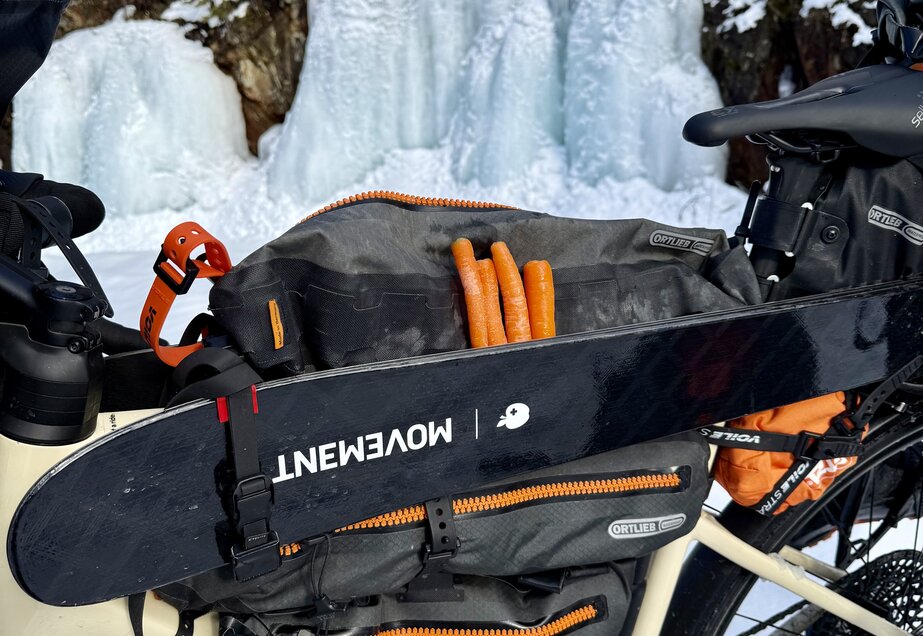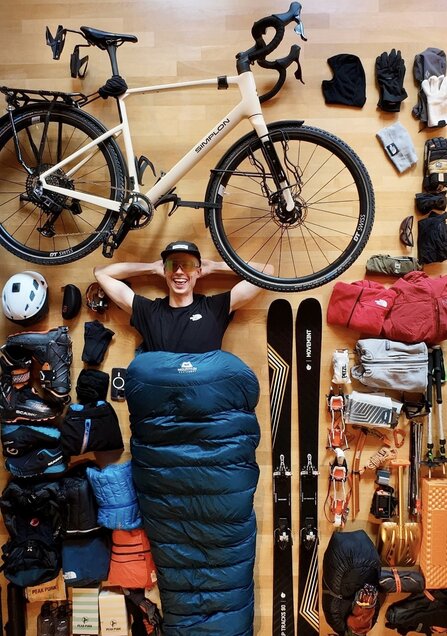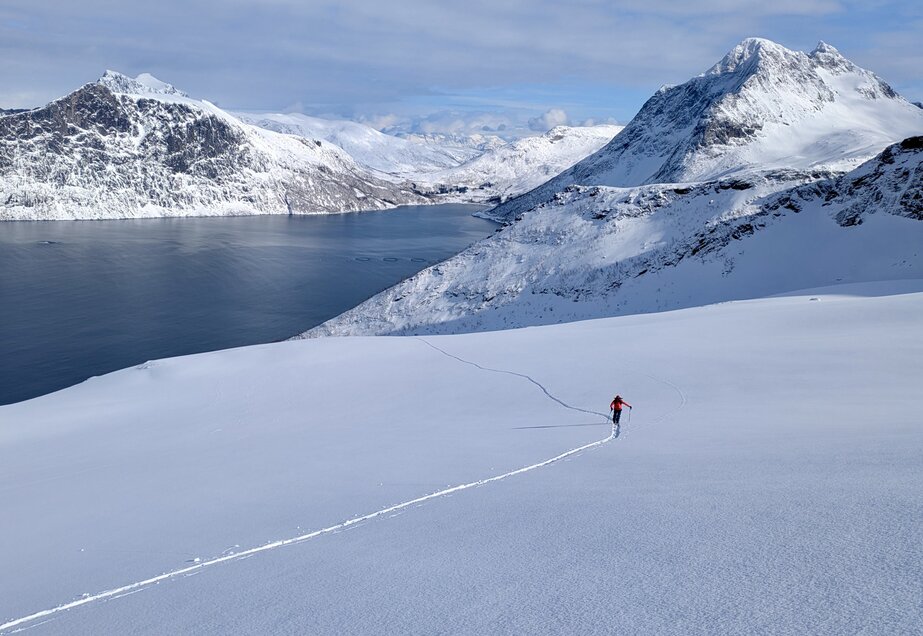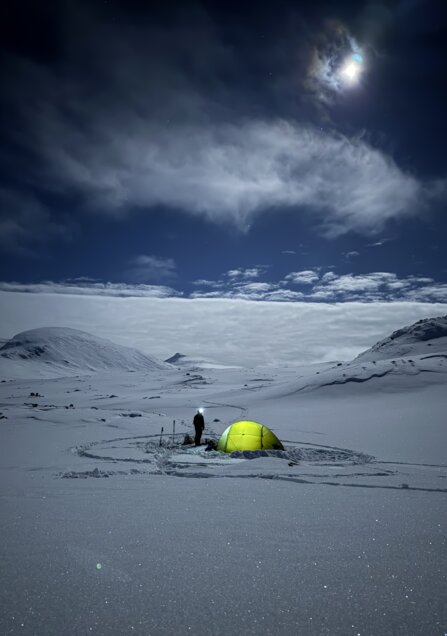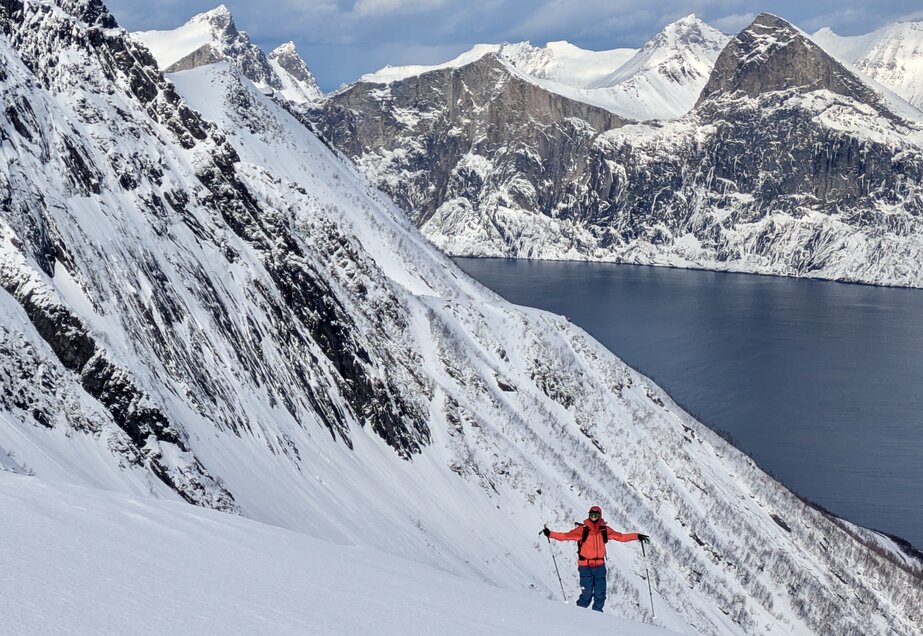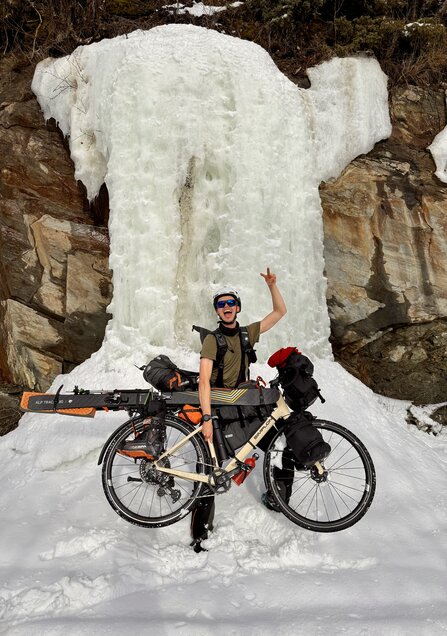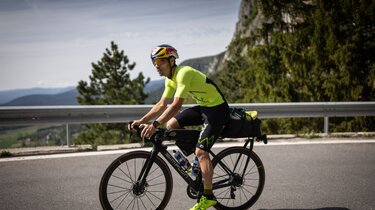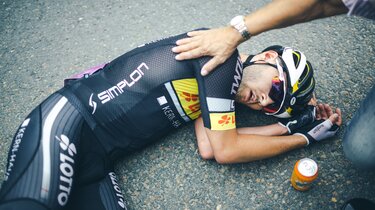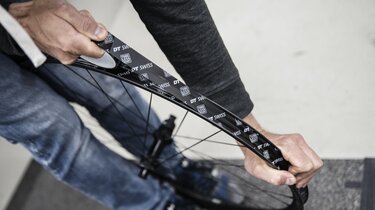

BIKEPACKING EXTREME - ACROSS NORWAY WITH A GRAVEL BIKE AND SKIS
If adventure had a name, it might be Simon Hiltli. The extreme athlete from Zurich set off in early March 2025 with his gravel bike, skis strapped on, and headed into the Norwegian winter for 50 days. What sounds like a crazy idea became reality: 2,500 kilometers, 45,000 meters of elevation, and countless unforgettable moments between snow, storms, and sunrises.
In this interview, Simon talks about how his bikeskiing winter adventure came to life, why he chose the SIMPLON GRID, and what it takes to travel through Norway by bike and skis.
SIMPLON: Simon, how did you come up with the idea to cycle through Norway in winter?
Simple: None of us owns a car, but we were eager to go skiing. Norway’s public transport network doesn’t compare to Switzerland’s, so the bike – or “Velo,” as we say in Switzerland – was the only option. The idea was to take the train north, then explore the country with bike and skis. That’s how our bikeskiing project was born – a mix of bikepacking and ski touring.
You chose the SIMPLON GRID gravel bike for your project. Why?
SIMPLON is a sporty, local brand focused on quality and durability. That convinced me. The headquarters is just an hour from Zurich, so I figured I’d ask the best if they’d like to support the project – and it worked.
The GRID was ideal. Sure, mountain bikes have advantages in snow, but for long distances and paved roads, a gravel bike is much more efficient. The durable 1x setup with a single front chainring and electronic shifting was perfect for riding with thick gloves, and the bike packs really well.
How did you prepare and pack your GRID?
Before the trip, I did a test tour to optimize the luggage system and get used to the bike’s weight. I’d recommend that to anyone planning a bikepacking trip. I also got studded tires – a real game changer for winter touring. They work great on snow and ice.
The extra mounting points on the GRID were especially helpful for attaching all my bags. I added straps to secure the gear to the bike. It makes sense to place heavy items as low and close to the frame as possible.
Image The skis were strapped along the top tube. That created a handy space for snacks at the front of the top tube. Fuel bottles for the stove went where the front-wheel dirt lands – those can get dirty anyway. With bikepacking, you pack and repack almost daily, trying different setups and getting better and faster over time. What took 90 minutes at first only took 30 in the end.
Everything’s packed. How do you approach such a massive project?
I used a combination of tools for planning – like Komoot, Google Maps, and Strava. The heatmap feature was especially helpful, showing popular routes in color.
The most important thing is maximum adaptability. Many factors can affect your plans on a trip like this. You constantly need to reassess the avalanche risk, for example. Originally, we planned a different route, but snow conditions changed everything. There was great fresh snow in Jotunheimen at the start, so we stayed there for 5 days to ski.
Then we moved on and realized that many roads are impassable by bike in winter. Cars detour through a vast tunnel system, which is often off-limits to bicycles. The solution: an open-source website called Tunnel Map, which rates tunnels by their bike accessibility and safety. Long straight lines on Google Maps are often a sign of a tunnel.
Where did you sleep during the trip?
We mostly camped outside in our base camp and spent about one night per week in a proper accommodation – to charge devices, do laundry, stock up on food, and plan the route. A big advantage of winter bikepacking: it’s super easy to find spontaneous accommodation.
What’s a Norwegian bikepacking base camp like?
Unlike a roadside camp – which is near the road and just for one night – the base camp is a multi-day home for bikepackers. Ideally, it’s on fairly flat ground in a beautiful natural setting, with access to flowing fresh water. That saves the time and effort of melting snow. Another key point: it must be in a safe location – protected from avalanches, strong winds, or other environmental hazards.
I treated our base camp like my home. That means clearly defined zones for things like cooking and sleeping. Snow is great for shaping furniture. For example, we built a kind of chair and put the tent over it so you could actually sit.
We stomped down paths in the snow to each zone, keeping the rest untouched and neat – even after 5 days. Otherwise, a base camp quickly becomes messy and chaotic.
Around the camp, we always trampled a large circle in the snow. When you get up at night to use the bathroom, you can’t just crawl back into your sleeping bag and fall asleep. You have to warm up first – and the circle was perfect for that. After a few laps, your body’s warm enough to sleep again.
Was there a situation that especially challenged you?
It’s a huge privilege to pull off a project like this. Not everyone can take two months off to bike and ski through Norway. And of course, there were tough moments – but this was our choice. And in every hard moment, we knew: it would get better again.
Still, I remember a few challenges. One time, a water bottle leaked and soaked the whole tent. That was rough – but eventually, we laughed about it. In moments like that, you have to mentally step back and see the situation from the outside. There’s always a solution, even if it feels like a worst-case scenario at the time.
Image Another time, a mountain pass was so snowed in it was impassable. The alternative – a tunnel – was closed to bikes. So, we strapped on our skis and set off – carrying the bike on our backs and dragging our gear on a kids’ sled from the supermarket. We had to cross two frozen lakes in strong wind. We barely spoke at the start. Everyone just thought: “Okay, let’s just f***ing do it.”
Carrying a bike on your back – that’s not something you see every day. What was that like?
Surprisingly, it went really well, even though I’d never practiced it. I took off the pedals and fixed the handlebar. Suddenly it felt super light – just 12 kilograms on my back. My base camp backpack weighed 25 kilos with food and everything. That’s a huge difference. It looked intense, but in the end, it wasn’t that bad. Today, it’s a funny memory.
Luckily, you could ride your bike most of the time – with about 30 kg of gear. How did people react to you?
Image The roads were mostly empty, so I could often ride side by side with my companions. Drivers never complained – they were incredibly considerate and respectful. One time, a van drove past and rolled down all the windows right next to us. It was full of people shouting and cheering. They were totally celebrating us. That had never happened to me before – it made me really happy and gave me so much energy.
In general, the people we met were incredibly kind. When you’re cycling through a country, people really empathize with you. Drivers would stop on the side of the road to ask what we were doing. That leads to conversations, exchanges, and real connections.
You were partly alone, partly with friends. How did you experience those different phases?
When you travel as a pair or group, you can split up tasks like setting up camp, learn from each other, motivate one another, and work through doubts together. If one of us was more hyped, the other would feed off that energy – and vice versa.
You spend so much time together and are rarely alone. With both of my friends, there came a moment after five days when we had to talk things out – all thoughts, opinions, whatever was building up. After that, everything was good again. The key is to address problems – ideally in a calm moment with a clear head. Then there’s really no problem at all.
Image When I said goodbye to my first companion after the first three weeks, it was emotional. You’re together 24/7 and then suddenly alone. I felt a bit strange at first. Luckily, I was on the bike, rode 800 kilometers in five and a half days, and had time to call my family and update lots of friends. That kept me busy – and the kilometers and long hours on the bike flew by.
And how did you deal with the extreme weather conditions?
The first few weeks, we camped in temperatures around –15 °C every night. That was a tough start. But after a while, we were ready. When temperatures rose to –2 or even 1 °C, we actually started sweating. The body adapts remarkably well to the cold, which is pretty crazy. Minus degrees have many upsides: dishwashing outdoors isn’t necessary since everything freezes instantly. And food gets preserved right away too—food safety isn’t a concern. Alcohol-free beer, however, isn’t worth buying—it freezes, too.
How did your GRID cope with the temperatures?
The bike performed incredibly well. Every day something failed—either the stove, a jacket laminate, or another piece of gear broke. That’s understandable—most equipment isn’t made for –10 °C. But the GRID never let me down.
After 10 days, a storm hit and my bike was flown 5 meters through the air before landing in the snow. Thankfully, nothing was damaged—I’d prepared for the worst. The bike needed the least amount of worry. Occasionally I lubed the chain, but that was it. I was especially happy with the electronic shifting. At –20 °C, I would take out the battery, warm and recharge it in the base camp, and reinstall it before riding. I never had any issues. I replaced the coin-cell batteries in the shift levers after 2,000 km. I always made sure nothing stayed frozen on the bike. When it got warmer, I positioned it so any water would drain off.
How did you recharge your physical energy stores?
My motto was: “Eat as long as there’s food!” I always carried more than necessary. I didn’t want to ration food mentally or physically for 50 days. You burn an incredible number of calories, so good nourishment is essential. The more you eat, the more energy you have—and the warmer you stay. It’s important to eat foods you actually like and balance flavors: sometimes sweet, sometimes sour, sometimes salty, sometimes neutral. I ate lots of dried fruits, nuts, energy bars, and sandwiches. I avoided foods with liquids—they would freeze immediately. Norwegian “polar bread” was awesome—it doesn’t freeze.
Norwegian supermarkets are perfect for bikepacking. They carry a wide range of ready meals, making camp cooking easy and budget-friendly.
Tacos were everywhere. So we started “Taco Friday.” Every Friday—sunshine or snowstorm—we celebrated veggie tacos to Mexican music. It took some seriousness out of the situation. It was just fun.
After dinner, I’d always finish with a slice of chocolate cake or chocolate bar. That definitely met my calorie needs. My friend even got up at night to snack. I couldn’t—but I always ate something right after waking. After the trip, I really appreciated not having to eat constantly all day.
What’s your final takeaway from the trip?
That it’s cool—you don’t need a van and you don’t have to travel to the other side of the world to experience an adventure. It’s all about motivation and mindset. I had a lot of respect for winter bikepacking, but it works. And in the end, you spend far more time on other things than biking or skiing. You pack, plan, melt snow. You have to manage so much that the actual physical activity feels like a reward for everything you did before and after.
On the second-to-last day, I skied a line and felt like I’d finally arrived. But of course, by the end you’re tired and looking forward to a break.
Thirsty for more adventure? Simon has thoroughly documented his tour. Find more on his Instagram: alpine.joker.
Simon’s Bikepacking Tips at a Glance
Before the trip:
- Physical prep: weight training and stability exercises to toughen ligaments and joints
- Mental prep
- Use digital tools like Google Maps or Strava, and seek local advice
- Digitize guidebooks and have various resources ready on mobile devices
During the trip:
- Have fun
- Be spontaneous and open to changes in plans
- Stay positive and distance yourself mentally when situations get tough
- In pairs or with a group: communicate openly and address issues
- Eat a lot and eat balanced meals
- Stretch regularly before, during, and after the tour
- Get as much sleep as possible
- Call friends or family in mentally tough moments for distraction
Packing tips:
- Use mounting points on the bike and add extra straps
- Keep heavy items low and close to the frame
- Avoid high-mounted rotating masses (e.g. large bottles)
- Keep key items (jacket, snacks) within easy reach
- Have patience, be creative, and stay adaptable
Winter camping & bikepacking tips:
- Use studded tires for riding on snow/ice
- For riding with thick gloves: use a bike with electronic shifting and a 1× drivetrain
- Choose flat ground for base camp
- Camp near flowing freshwater
- Stay protected from environmental hazards like avalanches or storms
- Keep your base camp tidy and well-structured
- Use wired headphones to avoid battery failure in cold weather
- Avoid liquid foods—they’ll freeze
- Insider tip: Norwegian polar bread (it won’t freeze)
- Have the supermarket cut fresh veggies and pack them in freezer bags for rationing
The Gravel Bike Simon Rode
SIMPLON GRID (Frame size L, 57 cm – Stack 618 mm, Reach 408 mm)
- Wheels: DT Swiss G1800 Gravel set, DT Swiss hub dynamo, DT Swiss 370 axles
- Drivetrain: SRAM Rival eTap AXS 12‑speed (38 T front, 10–52 T rear) on SRAM Rival 1 Wide (D1) crankset, 175 mm
- Brakes: SRAM Rival eTap AXS HRD FM hydraulic disc brakes
- Cockpit: SIMPLON carbon handlebars (42 cm width, tapered), SIMPLON 90 mm stem (-12°), carbon seatpost
- Saddle: Selle Italia Boost X3
- Pedals: HT Components Nylon Pa03a platform pedals
- Tires: Schwalbe Marathon Winter Plus
- Lighting: Busch + Müller IQ-X
- Racks & gear: Racktime Standit 2.0 rear rack, Rockbros Cargo Cage, SIMPLON kickstand
What’s next for Simon?
On 28 November 2025 he will set off on his next big adventure. From Zurich he’ll ride his gravel bike all the way to Kyrgyzstan, about 5000 kilometres, with skis and full winter camping gear packed. A journey that demands everything and promises unforgettable moments along the way.
You can follow him daily on our Instagram channel. We’ll share regular updates, photos and glimpses into his everyday life between snowstorms, sunshine and endless landscapes.

